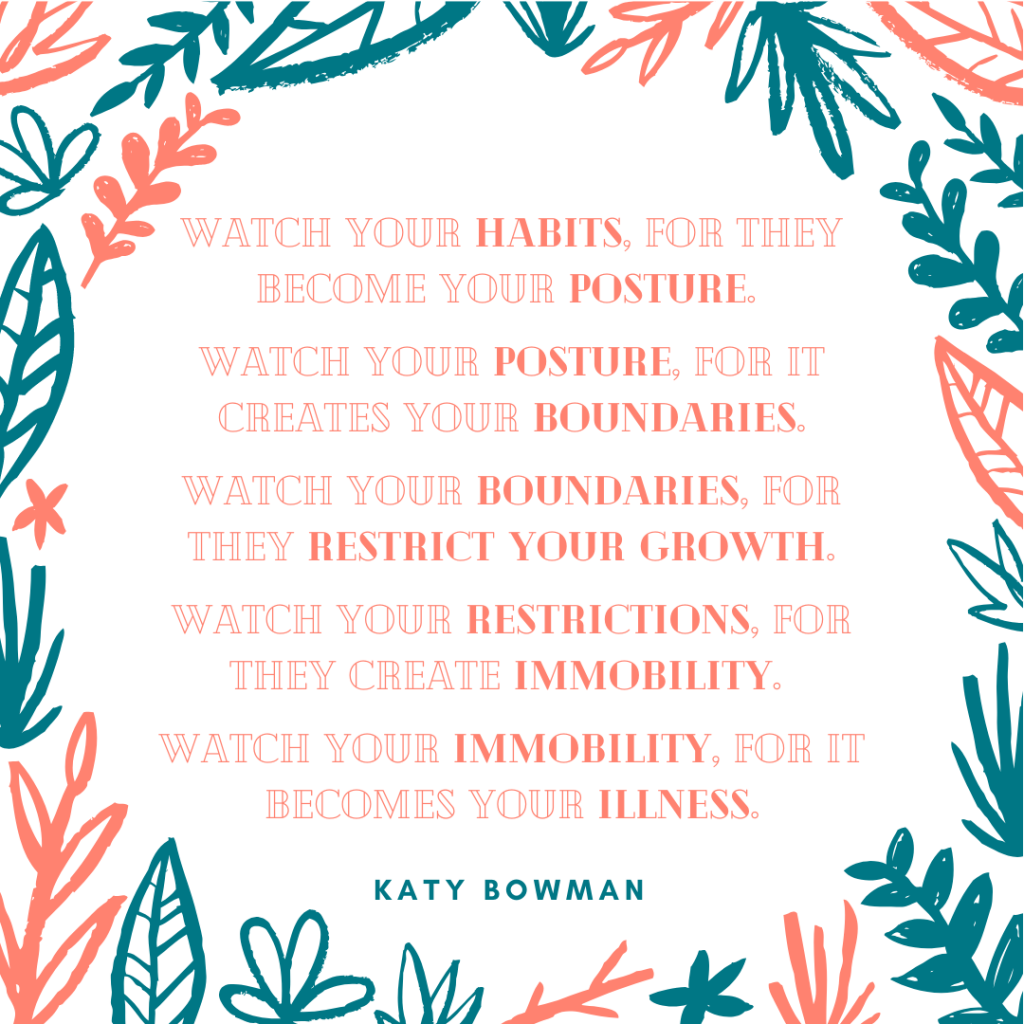This is the second part of a two part article on sitting. If you haven’t read the first article yet, read Part 1 before proceeding.

We sit a heckuva lot. We sit in our cars to go to work, we sit at our desks to do work, we sit to eat (sometimes at the desk or in the car) and then we’re tired and stressed to the point that we crash on the couch for the rest of the night. Other activities we’ve either made possible to do sitting or have eliminated the need to do them by hand altogether–mowing, getting our food, cooking said food, washing dishes, going to the bathroom and more. We tend to make things easier for ourselves with technology and the design of our homes.
Now we’ve made things so convenient that what’s required of us physically isn’t enough to keep our bodies functional. Our bodies–our cardiovascular system, muscles, and even bones–respond to the demands we place on them by adapting and becoming stronger. If we place minimal demand on them, we can’t be surprised when they can’t hold up under a medium amount of effort.
So in order to keep sitting from ruining our bodies, we can sit better (Part 1) and we can sit less.
Which is easier said than done. Because some technology I’m not willing to give up just for the sake of getting more movement. I LOVE my dishwasher, and I HATE washing my dishes by hand. And that’s a trade-off I’m willing to make because I cook more often when I don’t have to wash dishes. Instead of standing on my feet washing dishes, I use my freed up after-dinner time to package leftovers for other meals, go on a walk or tidy up. We don’t necessarily have to choose between our body or our technology. We do, however, need to be intentional in keeping our bodies running.
Most of our bodies need more physical effort than we’re providing them, and giving up a convenience here or there can be an easy way to make that happen. The gym isn’t a requirement (or even the silver bullet) for keeping us moving into our 90s. Doing a couple deep squats or lunges during the day because that’s what gets us off the floor where we were sitting? Walking to drop off your library book or pick up your kids from school? Choosing movement over convenience? Those movements can go much farther than a few gym sessions. They keeps us in motion, and they can help slow life down a little and make us aware of ourselves and our surroundings–something most of us could use more of.
So in that vein, here’s a listicle (that’s about as fancy as we get here) on How to Sit Less:
- Take breaks. This is not groundbreaking, but set yourself a timer to cue breaks for movement. Break Option Ideas:
- Printing to a printer farther away from you that you walk to
- Using a movement routine to get moving (MovNat, Katy Bowman, Primal Play)
- If you’re like me and can’t get back into the zone once you’re out of it, create a paper workspace or to-do chart on the wall near your computer to move back and forth from.
- My favorite workspace addition is a pull-up bar to hang off of. Let’s be honest, I suck at pull-ups (working on it). But even hanging gets me fuller shoulder range of motion and helps me breathe deeper.
- Lay down. If you’re working on a laptop at home, you can always lay on your belly and work that way. This allows you to pull your head and shoulders back while allowing your hips and knees to be in extension. I like to use this as an opportunity to work on hip mobility too. Just don’t do this one at the coffee shop.
- Side Note: People sometimes report pain in this position. If it’s low back pain, you probably have limited hip extension or your lumbar spine is arching too much. Or both. If that’s you, try sticking a bolster or cushion under your hips. Know that this is a sign for you to get more hip extension…Start with walking. If pain is in the middle of your back, the issue is a lack of thoracic extension. It may be resolved with some thoracic extension work. If either of these pains can’t be resolved, work with a practitioner to address the lack of spinal mobility or core stability.
- Buy or build yourself a variable workstation. Or (in my case) find a couple work stations around the home that you can cycle through. This could be a desk that raises or lowers (Varidesk or architect table), a bookshelf you can alter screen height with, a stool that goes up and down, a tall table that you can use standing or sitting on a stool, or a low table that could be used from the floor (and maybe a cushion for while you’re sitting there).
- One tool I find helpful with this is a keyboard that attaches to my laptop. This lets me put my screen at eye level without hiking up my shoulders no matter the workstation.
- If you’re using a standing workstation, you may want a pad under your feet or a rock mat for texture. What I wouldn’t recommend is getting big cushy tennis shoes with a ton of heel padding. Standing in positive-heeled shoes shifts your weight forward, which leads to low back pain because your upper body pulls back to compensate.
- Don’t Let Your Phone Tie You Down: If you’re on a phone call, stand, squat or walk. Obviously if you still have a corded phone that last one doesn’t work too well! But if you have phone calls that don’t require you to be next to your computer, walking lets you move and do work at the same time.
- Invest in some voice-to-text software. Voice-to-text tech can be useful if you write a lot, but it also ends up creating some very weird sentences. Setting up one of these softwares so that it really knows what you’re saying can be well worth it if you produce a lot of written content.
- Schedule walking meetings, and if you need to make notes use Evernote or another mobile note software. In bigger group meetings, you can always opt to stand in back.
- Build habits: You’ve heard it before: take the stairs! In reality, acheiving more movement long-term requires intention on the front end to design habits that last. To figure out how to keep moving more once you’ve started, I recommend The Power of Habit by Charles Duhigg. Understanding habit loops can help you create non-sitting habits that will last in your unique situation.
- Leave the car at home: Rather than parking way out in the parking lot, leave your car at home. Figure out what parts of your day you could bike or walk to. For some folks, this isn’t practical because of the distances involved in your day. For others, it’s simply figuring out what routes are available and where bike lanes and sidewalks are.
- If you’re moving homes and want to incorporate more movement into your day, make this a consideration. The last house I lived in was on a busy road, and I couldn’t safely ride or walk anywhere besides my smallish neighborhood. I had to drive somewhere to run, which meant it didn’t happen. When we moved houses, we picked a more walkable area, which means I move way more now. Walkability varies per area, but is worth considering if you want to integrate movement more easily into your day.
- Referring back to the habit note from above, incorporating walking is much easier when you set up a habit loop. For example, I live close to the library and getting parking there can be rough. So in my case, I walk to the library for books rather than stopping on my way home because I get movement in and eliminate parking lot road rage. It’s an extra 15 minutes, but I probably just would’ve sat on my phone.
- Read upright. I love stories…which usually means sedentary time. I can change positions somewhat as I work through books and shows, but using audiobooks lets me move exponentially more. (Thank you Indianapolis Public Library!) I can process through the same information, and if I want I can clip audio-bytes to come back to. When I was marathon training, rather than exercise cutting down my reading time, I actually doubled the amount of “reading” I did.
- Go on a walk after each meal, no matter how short. If you’re going out, see if you can go somewhere within walking distance. Or spend an extra 30 minutes on your feet making something from scratch. For some people, the mere thought of cooking is stressful. Start with where you’re at and figure out how to incorporate movement into that. For me, I find that doing a little chopping can be peaceful, but if there are very vocal starving mouths (or mouths that think they’re starving) to feed, then stick with a quick crock pot meal and head out after dinner to blow off some steam.
- Spend family time being active. I have little to no coordination when it comes to sports, but I do love to hike and ride bikes. A free afternoon spent outdoors with my other half leaves us in much better moods than going to a movie. For those of you who hate the idea of a walk (or can’t coerce your kids or significant other into anything resembling a walk), figure out something active that can be done together–play catch or basketball, find a playground, build something, go climbing or kayaking, take a cooking class, or see what free events/activities are in your area. Just because you’re the adult doesn’t mean you have to stop playing.
- Get down on it. If you’re watching TV, get up during ads or get down on the floor. Even small bits of added movement can change the impact of sitting and help pull you out of your Netflix-induced coma. Sitting on the floor means you’re doing at least one deep squat or lunge per day…and probably a few more than that!
- Go to bed earlier. Honestly, this is the absolute hardest for me. But most of the time that I spend multiple hours sitting is after dinner if hubby and I flip on the tv. He’s always researching something, so he uses this time to get things done. I on the other hand spend that time doing small tasks that take five times as long because the tv is on. I also tend to get less sleep and am sitting on my bum for hours at a time. So I’ve learned that for me, going to bed earlier means I’m more productive in the morning and I get more sleep. I’m not saying I’m great at it, but it’s getting easier because it definitely gives me a great start to my day.
The problem with quick tips to make you move more is that they won’t work the same way for every single person and they require you to change some habits. That said, by being intentional in how you move throughout your day, you can keep your body strong without having to put in hours at the gym.
As a last note, I’ll leave you with a quote from the biomechanist Katy Bowman from her book Alignment Matters:

For more resources, check out:
- Our Sitting Less Video!
- http://getamericastanding.org/index
- MovNat Sitting Resources
- Katy Bowman: Move Your DNA
- Darryl Edwards: Primal Play
Leave a Reply
You must be logged in to post a comment.